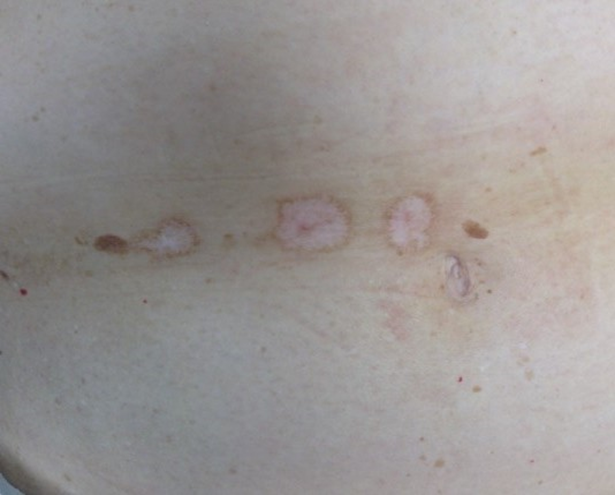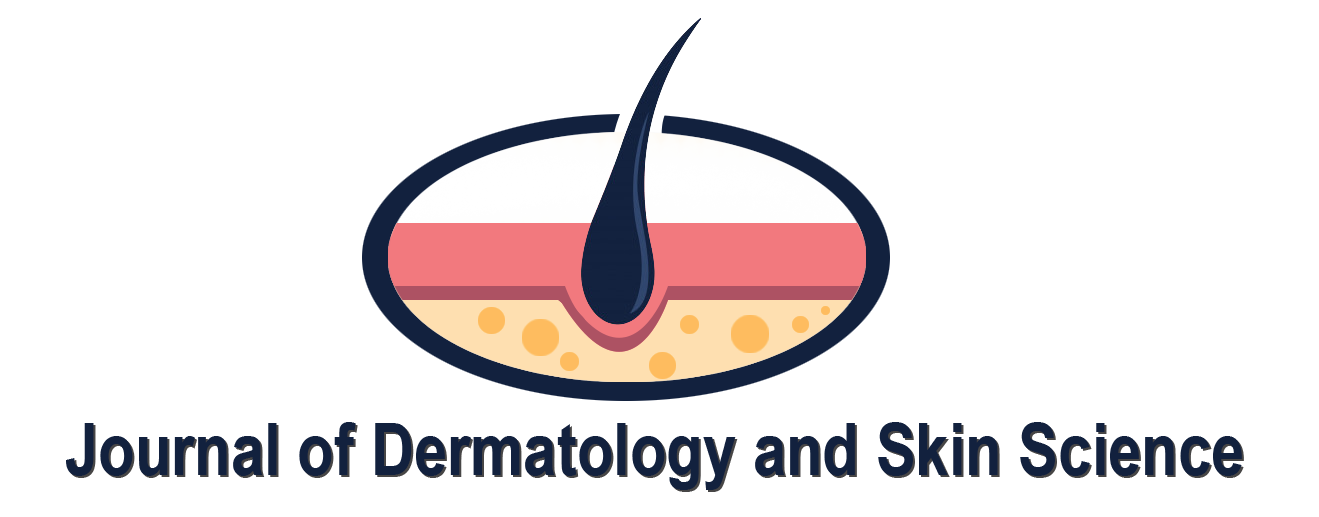Essential Oil-Induced Scarring
Shane M. Swink, D.O., M.S.1*, Tanya Ermolovich, D.O.1,2
1Division of Dermatology, Lehigh Valley Health Network, Allentown, PA
2Advanced Dermatology Associates, Ltd., Allentown, PA
A woman in her 60s presented with a four month history of asymptomatic white patches on her right abdomen. Physical exam was notable for three, ovoid, one to two-centimeter hypopigmented, firm plaques with light scale and skin atrophy with a brown peripheral ring in a linear array (Figure 1). The plaques were to the right of the umbilicus, directly in the line of the patient’s waistline. The anogenital skin, including clitoris and clitoral hood, interlabial sulci, labia minora, and perineum were uninvolved without evidence of fusion, erosion, or ulceration. The remainder of the patient’s complete cutaneous exam was unremarkable. Questioning revealed that four months prior, the patient applied three drops of commercial bergamot essential oil (doTERRA®, cold pressed oil from bergamot rind) to the areas using a circular applicator, with the intention of lowering her cholesterol. Twelve hours after application, the patient reported development of three large bullae at the application sites. The bullae were pruritic, and painful, became denuded after rubbing under the patient’s waistband, and healed without intervention into white patches after two weeks. The patient denied any sun or tanning bed exposure to the area after oil application.

Figure 1: Ovoid, hypopigmented, firm plaques with light scale and skin atrophy with brown peripheral ring on the right abdomen.
Given the history of a bullous eruption after bergamot oil application, followed by atrophic scar-like lesions, a diagnosis of scarring after a bullous allergic contact reaction was made. The patient stopped using the oil after her initial reaction without the development of any new lesions. Given the asymptomatic nature of the lesions at time of presentation, the patient deferred treatments for the scars. Patch testing was offered to the patient to confirm an allergy to bergamot, which she also deferred given her cessation of the product. Oil of bergamot is derived from rinds of the bergamot orange (Citrus aurantium spp bergamia) and is a common addition to aromatherapy and essential oil products due to its pleasant smell. The use of essential oils as natural alternative remedies to promote physical and psychological wellbeing has been increasing in popularity around the world.1 Essential oils, specifically bergamot, are used as a panacea by the natural and alternative medical communities for mood alteration, anxiety and stress relief, pain reduction, and to treat cardiovascular, bone, inflammatory, and skin diseases.2 However, bergamot oil contains furocoumarins and is classically known as a cause of phytophotodermatitis after exposure to ultraviolet radiation.3 Bergamot oil has also been identified as a rare cause of allergic contact dermatitis.4 Under occlusion and friction, like that of the waistband of our patient, allergens trigger a more robust inflammatory response. The vigorous inflammatory response to bergamot oil under waistband occlusion, subsequent bullae formation, and denudation led to the atrophic scar-like lesions in this patient.
The differential diagnosis of these lesions includes extragenital lichen sclerosus, vitiligo, tinea versicolor, and anetoderma. Accurate diagnosis of thin atrophic scars subsequent to bullous reactions, including allergic contact dermatitis, is imperative to avoid unnecessary treatments, laboratory workups, and skin biopsies. The lack of regulation regarding purity or potential contamination of essential oils raises the concern of unreported agents being found in these oils, further risking adverse cutaneous reactions. Future chemical analysis of these oils may provide more insight into their purity and true composition. Given the increased frequency and popularity of essential oil use in patients seeking natural treatments for a variety of medical conditions, combined with the potential omission of their use when providers inquire about personal care products, clinical suspicion for an adverse reaction to these oils should be raised for new cutaneous lesions and eruptions.
Conflict of Interest
None declared
References
- Boonchai W, Iamtharachai P, Sunthonpalin P. Occupational allergic contact dermatitis from essential oils in aromatherapists. Contact Dermatitis. 2007; 56(3): 181-2.
- Perna S, Spadaccini D, Botteri L, et al. Efficacy of bergamot: From anti-inflammatory and anti-oxidative mechanisms to clinical applications as preventive agent for cardiovascular morbidity, skin diseases, and mood alterations. Food Sci Nutr. 2019; 7(2): 369-384.
- Kaddu S, Kerl H, Wolf P. Accidental bullous phototoxic reactions to bergamot aromatherapy oil. J Am Acad Dermatol. 2001; 45(3): 458-61.
- Trattner A, David M, Lazarov A. Occupational contact dermatitis due to essential oils. Contact Dermatitis. 2008; 58(5): 282-4.
